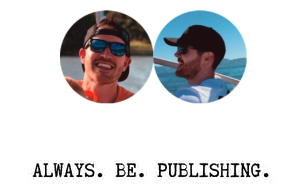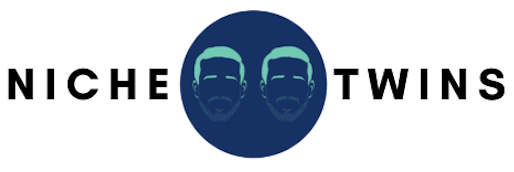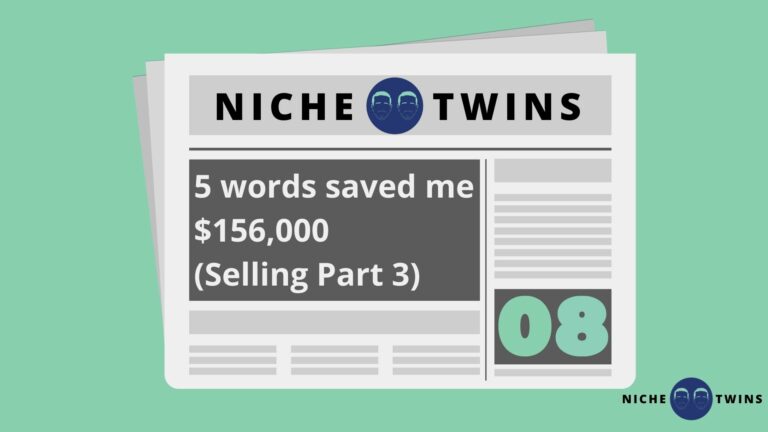Do you remember your first ever pay-check as a W2 employee?
I do.
It was 2012.
I had just graduated college.
I landed an entry level job at Dana Farber Cancer Institute in Boston.
I still recall trying to “negotiate” my pay. Aways negotiate!
I made my long winded plea to the lady from HR.
She paused a moment and then said, and I quote:
“Yaaaa so the pay is the pay, that’s not changing. If you still want the job, give us a call back”.
Before she could even finish I basically screamed, “I’ll take it!”.
I took a few classes on negotiation in college. Nbd.
The pay was $17.97 an hour.
$718.00 a week.
Then my first check came in the mail.
It was for $572.51.
Wtf?
Obviously a mistake.
Right?!
Ohhhh sh*t.
I forgot about taxes…
Uncle Sam
When it comes time to sell your content site, or any business for that matter, the one thing you cannot afford to forget about is taxes.
It’s easy to overlook.
But even a small misstep here can cost you a fortune.
My first piece of advice – have your CPA look over the draft Asset Purchase Agreement (APA) with you.
Specifically the “Allocation of Purchase Price” section.
If you don’t have a CPA, find one and pay them for an hour or two of their time.
It’s worth every penny.
Because how you structure the Allocation of Purchase Price section of the APA will ultimately determine how much you pay in taxes.
And since it also affects how the buyer will be taxed, it can become a point of contention during the negotiations.
Here’s the gist:
For most business sales, five categories are used in the allocation of purchase price:
- Furniture, Fixtures & Equipment – value of tools, desks, chairs, computers, other hard assets
- Inventory – value of the in-stock goods you’re leaving with the buyer
- Training – value assigned to training/consulting the new buyer post-closing
- Non-compete – value assigned to agreeing to not compete with buyer for a certain amount of time
- Goodwill – total sale price minus the previous 4 categories. Think of Goodwill as your company’s brand – its reputation
Your goal is to get as much of the sale price allocated to Goodwill as possible.
Why?
Because Goodwill is considered an asset.
And as long as you’ve owned your asset (your business) for more than one year, your Goodwill will be taxed as long-term capital gains.
Long-term capital gains are taxed according to thresholds which begin at 15% and go up to 20%.
All the other categories above are taxed at ordinary income rates, which can be as high as 37%.
That’s how these five words, “100% allocated to Personal Goodwill“, saved me $156,000 when I sold my site earlier this year.
The sale was taxed as a long term capital gain ($177.375), instead of income ($333,465).
Hand-off of assets
Ok, now that you’ve got your Asset Purchase Agreement signed-off on, it’s time to hand-over your assets to the buyer.
This was probably the most surprising part of the entire sale process.
I imagined some complex procedure.
Maybe some assistance.
Nope.
You hop on a Zoom call with your buyer, and you hand-off each asset, one-by-one.
That’s it.
Nothing fancy.
I did a bunch of pre-work to ensure my hand-off was smooth.
Essentially I just created a Google Sheet of all the various accounts that needed to be transferred, along with the associated URL.
Then I researched (Googled) how to transfer ownership.
Most transfers were pretty straightforward.
I included the more complicated transfer instructions in the sheet.
I also made sure to turn off 2FA (Two-factor authentication) on any accounts that had it enabled.
Once the buyer and I joined the Zoom call, I shared the Google Sheet with him and we just worked our way down the list.
I started with the Gmail account I had associated with the site.
Once this was handed over, the buyer was able to SSO into about half of the accounts right off-the-bat.
For the remaining accounts, I simply changed the password to a temporary “hand-off” password.
I shared that password with the buyer.
They logged into the account, and changed the password.
And voila – after about 1 hour the asset hand-off was complete.
You may have noticed that Ezoic (the display ad company I used to monetize the site) wasn’t included in my hand-off.
That’s because Ezoic requires the buyer to set up an account of their own.
The buyer also needed their own Google Ad Manager and Adsense accounts (Google policy).
Escrow
Time to get PAID.
You’ll actually technically engage with the Escrow company just prior to doing your asset hand-off.
You need an Escrow Agreement in place, and then the buyer will wire the funds so that they are sitting in escrow before you hand anything over.
We used Ecommerce Law Group.
They charged us 500 bucks each (buyer and seller), $1000 total to facilitate the transaction.
Here’s what the escrow timeline looked like:
- Feb 27 – We both signed the Escrow Agreement
- Feb 28 – Buyer wired funds to escrow
- Feb 28 – Escrow agent let us know when she received the funds so we could begin the hand-off of assets
- Feb 28 – Once assets were transferred, we each emailed escrow agent separately informing her
- Feb 28 – Escrow agent sent yet another document for us to sign, breaking down the funds flow instructions
- Mar 1 – I got a $100 test wire that I had to confirm receipt of
- Mar 2 – Remaining funds were released to me!
And yes, I was refreshing my Capital One bank account app about every other minute on March 2nd 😅.
Now what?
You’re not done yet!
Most Asset Purchase Agreements have a section regarding training.
It’s pretty common for the buyer to request 40 hours of support over the first 90 days, post-sale.
Basically the buyer will reach out when / if they need help.
My buyer and I have met about 10 times so far, for less than 10 hours total.
I imagine we’ll meet just once or twice more.
Once your 40 hours are up, or the 90 days, which ever comes first, then you’re truly done.
Congratulations.
Sale complete.
Time to enjoy the weekend.
You’ve earned it.
-Mike

Niche Twins newsletter sent weekly on Fridays at 8:30 AM ET



Your story is more than inspiring for a novice blogger like me. I always get excited to receive the Niche Twins email. Keep doing you!
Thank you!
Do you know parasite seo or have any courses i can buy?
We don’t practice parasite seo or sell any courses! Loads of good free resources online though. Decent place to start: https://moz.com/learn/seo
Your blogging journey is interesting Mike. For a novice blogger like me, I always enjoy reading your newsletters and blogs alike.
Your story is inspiring for blogging beginners and is spreading more positive hope to the needy starters.
Thanks for sharing these helpful insights.
Thanks Karim, appreciate the kind words